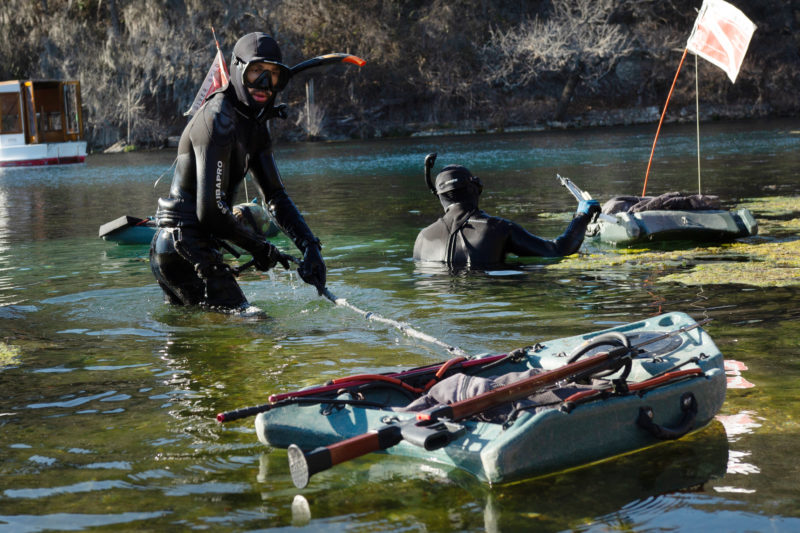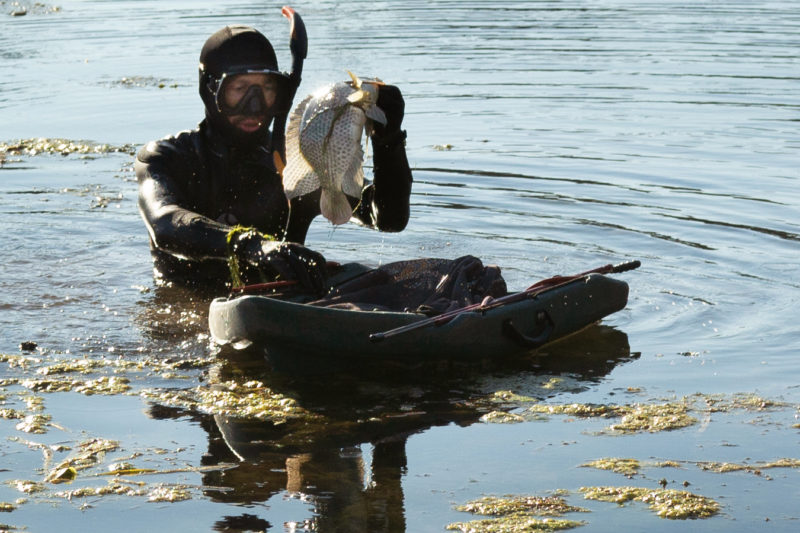Invasive Aquatic Species Are Threatening Texas Waterways
By Marina Garcia
Reporting Texas

Nick Menchaca gets into the water to start searching for invasive fish as the Meadows Center for Water and Environment conducts glass-bottom boat tours at Spring Lake near San Marcos, Texas, on Feb. 27, 2022.. Jessie Curneal/Reporting Texas
SAN MARCOS — Across the street from Sewell Park, while most people tried to get a suntan or go tubing on a cloudy day, a group of researchers worked to capture suckermouth armored catfish, an invasive species in the San Marcos River.
The fish are seemingly invisible in the murky water, but the researchers from Texas A&M University and the Meadows Center for Water and Environment spotted a few and were quick to begin their work.

Christopher Riggins, left, pulls his spearfishing equipment with Collin Garoutte as the two hunt for invasive fish at Spring Lake near San Marcos, Texas. Jessie Curneal/Reporting Texas
It was a game of patience as two scuba divers from the Meadows Center searched the chilled water to capture invasive fish with their nets, people walking by pausing to see if they catch anything.
The team did seize a handful of the beady-eyed fish — a great way to conclude National Invasive Species Awareness Week.
Those numbers are nothing compared with the more than 400 suckermouth armored catfish captured in the San Marcos River on Jan. 13 by the environmental consulting firm Atlas Environmental. The removal aimed to help researchers study the invasive fish that they say threaten the river.
Invasive aquatic species such as the suckermouth armored catfish compete with native species for food, cause erosion and wreck ecological damage, experts say.
“Invasive (species) have serious ecological ramifications to the native ecosystems,” said Sul Ross University biology professor Dan Foley.
Monica McGarrity, a senior scientist for aquatic invasive species with the Texas Park and Wildlife Department, says three of the most common invasive species in Texas streams, rivers and lakes are the suckermouth armored catfish, blue tilapia and zebra mussels.
Blue tilapia
Native primarily to Africa, blue tilapia were commonly sold as live bait before the Texas Park and Wildlife Department started regulating the fish in 1997.

Christopher Riggins pulls an invasive tilapia into his net on Feb. 27, 2022. He and his team caught 19 fish during the search at Spring Lake near San Marcos, Texas. Jessie Curneal/Reporting Texas
Blue tilapia are unique for their blue-gray bodies and wide belly. They grow to an average of 5 to 8 inches and weigh 5 to 6 pounds. The fish are sometimes sold in restaurants and grocery stores and raised on farms.
“They’ve had devastating effects on the vegetation. Through their feeding activity, they can also end up unintentionally eating eggs that belong to other fish that are laid on the vegetation,” McGarrity said.
Blue tilapia have been reported in the San Marcos and Comal rivers, according to the Texas Initiative database on invasive species. Populations of blue tilapia are also in the San Felipe Creek and Morris Creek, Foley said.
The blue tilapia has infiltrated waterways in other states, including Arizona, California and Nevada. Florida is a hot spot of the fish, where it is out-competing native fish, according to the Florida Fish and Wildlife Conservation Commission.
While limited research exists on long-term effects of blue tilapia on the ecosystems, McGarrity said, the Texas Parks and Wildlife Department sees the fish as a threat and is trying to combat its growing numbers.
State regulations dictate that blue tilapia caught in the wild must be killed, McGarrity said. Blue tilapia can only be kept for agricultural practices like aquaponics — which involves raising fish and aquatic plants together in a closed system — and in stock ponds, she said.
Zebra mussels
Zebra mussels crossing into the United States from Eurasia can be traced to the late 1980s. The mussels can latch onto boats and were first found in Texas in Lake Texoma on the Texas-Oklahoma border in 2009, McGarrity said.
“They’ve since spread to 28 lakes (in Texas) that are considered fully infested,” she said.
Zebra mussels damage boats and other infrastructure and compete with local Texas mussels, McGarrity said.
Zebra mussels already have caused financial issues for Austin. They polluted Austin’s largest water treatment plant in 2019, which cost the city $1.1 million to fix, according to reporting from the Austin American-Statesman.
“They can get into the infrastructure of any facility that uses raw surface water, whether it’s water supply or hydroelectric,” McGarrity said.
Because zebra mussels can be transferred from one body of water to another by attaching on to boats, Texans are prohibited to possess and transport them, McGarrity said.
Texas Park and Wildlife is trying to combat zebra mussels through its clean, drain and dry initiative, she added.
“It’s critical that (boaters) drain all the water out of the boat and let the boat completely to make sure any mussels that might be on or in the boat are killed,” McGarrity said.
Unlike the suckermouth armored catfish and blue tilapia, zebra mussels are usually invasive to lakes rather than rivers and streams.
Suckermouth armored catfish
The suckermouth armored catfish is native to South America. The population is quickly growing in the San Marcos River, the San Antonio River and the San Felipe Creek, according to the Texas Invasive Species Institute.

Native fish are threatened by invasive species which compete with them for food at Spring Lake near San Marcos, Texas, on Feb. 27, 2022. Jessie Curneal/Reporting Texas
The suckermouth armored catfish poses threats beyond simply outcompeting native fish for food, McGarrity said.
“They also dig burrows into (river) banks, and they can cause erosion, decrease water quality, water clarity, and they can even destabilize banks,” she added.
The suckermouth armored catfish are spreading throughout the state, Foley said.
“They’re spreading to other aquatic resources. … That’s how the population is really increasing,” Foley said. The fish can live and thrive in rivers, ponds, lakes, and oceans, he added.
The fish can grow up to three feet, have thick spines in their fins and have black spots throughout their bodies.
In Texas waters, they have no natural predators because of their rough scaly skin, Foley said.
“I would describe (them) as an underwater armadillo,” Foley said. “They’re hard to handle, and they’re hard (for predators) to swallow.”
The fish is also labeled as invasive in Florida, Nevada and possibly Wisconsin, according to the Texas Invasive Species Institute.
The armored suckermouth catfish’s presence in Texas waterways can be explained by aquarium dumping, Foley said. “When a pet either becomes no longer wanted, or can no longer be housed … (they are sometimes) dumped into the nearest water source,” Foley said.
Dumping is a major problem, McGarrity said, and Texas Park and Wildlife is working to educate the public on aquarium dumping through its Never Dump Your Tank initiative.
“It’s a big effort nationwide to try to reach out to these pet stores and reach pet owners so that they do the right thing and don’t release these fish,” she said.